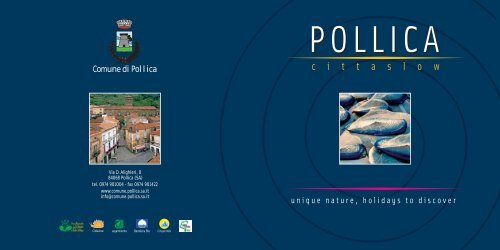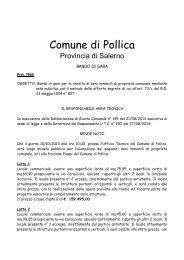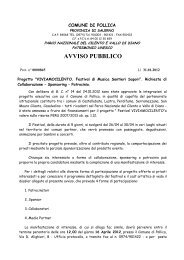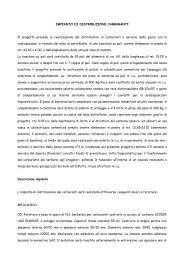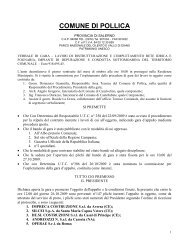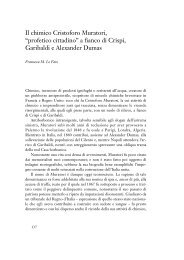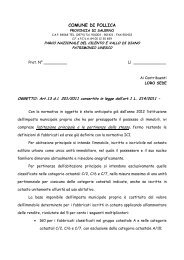Traditions - Comune di Pollica
Traditions - Comune di Pollica
Traditions - Comune di Pollica
You also want an ePaper? Increase the reach of your titles
YUMPU automatically turns print PDFs into web optimized ePapers that Google loves.
<strong>Comune</strong> <strong>di</strong> <strong>Pollica</strong><br />
Via D. Alighieri, 8<br />
84068 <strong>Pollica</strong> (SA)<br />
tel. 0974 901004 - fax 0974 901422<br />
www.comune.pollica.sa.it<br />
info@comune.pollica.sa.it<br />
Cittaslow Legambiente Ban<strong>di</strong>era Blu<br />
Cinque Vele<br />
POLLICA<br />
c i t t a s l o w<br />
unique nature, holidays to <strong>di</strong>scover
<strong>Pollica</strong> Land and Sea<br />
The administrative <strong>di</strong>strict, or comune, of <strong>Pollica</strong> lies entirely within the<br />
National Park of Cilento and the Vale of Diano and is situated in the ancient<br />
land of Cilento. It lies on hill and coastal land, and it has a rare wealth of<br />
suggestive landscapes which conserve unspoilt the variety of architectural<br />
styles, especially inland.<br />
The comune consists of the principle village <strong>Pollica</strong> (the capoluogo) and<br />
its five dependent villages. Two of these (Acciaroli and Pioppi) are on<br />
the coast and three (Cannicchio, Celso and Galdo) are inland. Seen from<br />
the sea, this corner of Cilento presents a scenario of simple beauty:<br />
spectacular hills gently lapped by the sea, clusters of houses nestled<br />
on the coastal slopes which bloom with cistus (rockroses), broom,<br />
olive groves and pine trees. Everywhere there is colour and the scents<br />
of land and sea.<br />
<strong>Pollica</strong> Cittaslow<br />
<strong>Pollica</strong> is a member of the international network of Città'e0slow<br />
(Slow Cities), an association designed to uphold tra<strong>di</strong>tions and<br />
protect land and culture. Living in a Slow City is a whole way<br />
of being: daily life is not frantic, and slowing down means<br />
fin<strong>di</strong>ng time to appreciate the tastes, colours and scents<br />
around us. This does not mean being stuck in the past, but<br />
living the present in the best possible way. It implies<br />
constantly looking to the future without ever forgetting the<br />
wealth of experience that we inherit from the history and<br />
culture of our people, as well as using the technological<br />
opportunities of our time to pass these values on. A Slow<br />
City proposes, not only for its inhabitants, but also to<br />
all those who visit it, the philosophy of “good living”,<br />
protecting the environment, agriculture, the social<br />
structure and tra<strong>di</strong>tional local food production, whilst<br />
harmonising natural rhythms with those of culture<br />
and economics.
POLLICA<br />
The first citation of <strong>Pollica</strong> was in 1113 in a document which attests the transfer of<br />
<strong>Pollica</strong><br />
properties in the village from Torgisio II Sanseverino to the Abbey of Cava. At the<br />
end of the 13th century the village belonged to the D’Alemagna family, then the<br />
Capano family, who were originally from Rocca Cilento. The Capano princes held<br />
<strong>Pollica</strong> until the family line came to an end (1795), when the feud was inherited and<br />
maintained by the De Liguori family until the end of the feudal system.<br />
The Castello dei Principi Capano (Castle of the Capano Princes) was inherited in 1290<br />
by Guido d’Alment, who came to Italy during the reign of Charles I of Anjou, and<br />
was subsequently bought by the Capano family. The castle as it is today is the result<br />
of restoration work carried out in 1610 by Vincenzo Capano. The impressive square<br />
tower, with a single monofora window on each of its 3 floors, is very picturesque<br />
and dominates the little village centre. The enchanting service areas of the castle<br />
- the ugliaro (a store room for oil), olive press, guard room and stables - are<br />
simple and well-preserved.<br />
Accor<strong>di</strong>ng to local tra<strong>di</strong>tion Saint Alfonso De’Liguori stayed in Capano Castle when he<br />
collected information in <strong>Pollica</strong> on pagan customs in Cilento. A room in the castle is still<br />
known as “Saint Alfonso’s room”. The castle was bought by the local council in 1997.<br />
Festival<br />
2nd July - Festa della Madonna<br />
delle Grazie. Procession through<br />
the streets from the convent to<br />
the parish church, led by the<br />
‘cente’ (ex voto, or offerings, in<br />
the form of boats carried on the<br />
heads of bare-footed women),<br />
and by the confraternity.<br />
The Convento Francescano <strong>di</strong> Santa Maria delle Grazie (Franciscan Monastery of Santa Maria<br />
delle Grazie) was begun in 1611 and finished in 1625. After various events that determined<br />
its closure and reopening on several occasions, it has been operating continuously since<br />
1931, when it was restored, improved and reopened by Father Vincenzo Riccio of Siano.<br />
The church houses four small altars on the sides, three of which bear the coat of arms of<br />
the Capano family. The altarpieces that line the entrance are striking; they are attributed<br />
to the Neapolitan painter Malinconico, a follower of Luca Giordano. The panelled wooden<br />
ceiling, by Giuseppe Marrocco of Celso, surrounds a painting by M. Cilento depicting the<br />
Assumption. Particularly worth seeing are the 18th century wooden choir, the 1741 organ,<br />
the sacristy with its wooden ceiling, a large cupboard from 1772 and a snail-shaped lavabo<br />
in sculpted stone.<br />
The Chiesa <strong>di</strong> San Pietro (St. Peter’s Church) is the oldest in <strong>Pollica</strong>. Built in 1524 it was<br />
once a public oratory belonging to the Pepe family. In the little church, now deconsecrated,<br />
the family arms can be admired on the main door and inside, in the central nave, there is<br />
a beautiful polychrome marble altar and a stone holy water font.
ACCIAROLI<br />
Acciaroli<br />
The first mention of a village named Aczarulo (probably derived from “lazzarolo”,<br />
a shrub from the Rosaceae family, similar to hawthorn) was in 1165. In 1187 there<br />
is mention of a church (Sancta Maria of Acciarolo) which, with its adjoining land<br />
and the tower built by the Normans in the 12th century, belonged to the Sanseverino<br />
family. In the 17th century it passed to the Capano family of <strong>Pollica</strong>. Acciaroli had<br />
a certain importance as a customs base until the 19th century.<br />
The Chiesa dell’Annunziata (Church of the Annunciation) is very old, but can only be<br />
traced back to the 16th century, when Fabrizio Poderico, feudal lord of Cannicchio,<br />
gave a piece of land adjoining the chapel to the Franciscans for the construction of<br />
a covent, which was then <strong>di</strong>ssolved in 1652. The present church has been renovated<br />
many times, most recently in 1971. Of particular interest are the majolica compositions<br />
representing the Annunciation on the tympanum of the church, and the bell tower<br />
which, together with the Norman tower, characterises the panorama of Acciaroli.<br />
As early as 1223 the Norman Tower was classed by the Holy Roman Emperor Frederick<br />
II as a coastal defence tower. The Spanish later also used it, along with the tower at<br />
Caleo, in their coastal defence system. In the 1960s the tower was bought and<br />
restructured by the Schiavo family.<br />
The solid structure of the Caleo Tower stands just outside the village centre in the<br />
<strong>di</strong>rection of Pioppi. Built around 1520, for the lord of Cannicchio, it has a similar<br />
history as the Norman tower, but has not been restructured.<br />
Festival<br />
Second Sunday in August<br />
Festa <strong>di</strong> Maria Santissima<br />
dell’Annunziata. There is<br />
a procession by boat<br />
along the coast and a<br />
spectacular firework<br />
<strong>di</strong>splay over the sea
CANNICCHIO<br />
Cannicchio<br />
The first mention of a church on the coast “Sancto Primo de Canniclo”, is in a parchment of 994<br />
conserved in the Abbey of Cava. Accor<strong>di</strong>ng to legend, after the destruction of San Primo, the<br />
refugees fled to the hills and founded Cannicchio. The village dominated Acciaroli for many<br />
centuries, and indeed many of the first families who populated the marine village of Acciaroli<br />
from the 17th century were in fact originally from Cannicchio. The village lines the crest of a hill<br />
and has a very particular urban structure which highlights the defensive aim of the buil<strong>di</strong>ngs:<br />
they are joined together, giving a heavy, solid appearance, almost like fortresses, with few openings<br />
on the ground floor. There are characteristic parts to the village with me<strong>di</strong>eval arches and towers.<br />
Accor<strong>di</strong>ng to tra<strong>di</strong>tion, the original chapel of the Chiesa <strong>di</strong> San Martino (Saint Martin’s Church)<br />
was built by three bishops sheltered from a storm by the lords of Cannicchio. Enlarged in<br />
1580 with the help of all the residents of Cannicchio, it has three naves and a very welcoming<br />
atmosphere.<br />
The Cappella <strong>di</strong> San Rocco (St.Roch’s Chapel) was built after the plague of 1508 at the point<br />
where, with the help of the saint, the plague ended, and the village was saved. The entrance<br />
to the chapel was formerly through a pronaos but this no longer exists.<br />
The Cappella della Madonna del Soccorso (Chapel of the Madonna del Soccorso) was built<br />
before 1580 on the site where the Madonna appeared to a girl possessed by the devil. It later<br />
belonged to the local Confraternity and became their seat.<br />
Festival<br />
8th September<br />
Festa della Madonna<br />
del Soccorso
CELSO<br />
The first historical citation of Celso is found in a document from 1050. The origin<br />
of the village is however much older and is correlated to families from <strong>Pollica</strong><br />
taking refuge in the hills to escape from village feuds and arguments. Celso<br />
preserves the ancient urban structure which makes it particularly characteristic,<br />
especially in the areas of San Biase and Valle.<br />
Celso<br />
The Palazzo Baronale Mazziotti (Palace of the Mazziotti Barons) is a national<br />
monument, and it is here that Matteo Mazziotti was born, a member of<br />
Parliament in the 1920s and eminent scholar of the Cilentan Risorgimento<br />
movement.<br />
The church of Celso is de<strong>di</strong>cated to the Madonna dell’Assunta (Our Lady of<br />
the Assumption). The main door into the church of three naves is on the<br />
façade of local stone decorated with brick cornices. The baptismal font of<br />
1771 in sculptured stone stands out, as does the stone holy water font of<br />
1625. The bell tower,which is very low with respect to the size of the church,<br />
was built in the 18th century.<br />
The Chiesetta <strong>di</strong> San Giovanni (St. John’s Church), probably built in 1503,<br />
stands on the country road from Celso to Casalvelino. The little church of<br />
the former village Praganito, it was mentioned for the first and only time<br />
in a donation made by Torgisio II Sanseverino to the Abbey of Cava. The<br />
village <strong>di</strong>sappeared probably in the 12th century.<br />
The Convento <strong>di</strong> Costantinopoli (Constantinople Convent) was built in the<br />
15th century, when refugees from Constantinople, assaulted by Mohammed<br />
II, fled the sacking of their city and wanted to build a place of culture<br />
de<strong>di</strong>cated to Our Lady. In 1610, Antonio Griso, lord of the area, entrusted<br />
the chapel to the Augustine monks, who founded a convent, but it was<br />
<strong>di</strong>ssolved after about a decade for lack of resources.<br />
Festival<br />
28th July<br />
Festa <strong>di</strong> San Celso
GALDO<br />
This is the most evocative village of the comune as it is the only one to have preserved<br />
completely intact the simplicity and soundness of the characteristics of the tra<strong>di</strong>tional<br />
Cilentan village. The name Galdo is of Longobard origin, and means “woods”. It is<br />
cited for the first time in a document of 1092.<br />
Galdo<br />
The Chiesa <strong>di</strong> San Nicola (St. Nicholas’ Church) is isolated from the village and for this<br />
reason appears all the more solemn and majestic. It was built in the 14th century,<br />
although the church today is the result of restoration dating from the 17th century.<br />
The interior with three naves is now completely devoid of the old stuccoes which<br />
decorated the altar, the beautiful wooden choir and the 17th century organ.<br />
The Palazzo dei Baroni Gal<strong>di</strong> (theGaldo Barons Palace) is an old buil<strong>di</strong>ng of 1605 with<br />
an impressive doorway. The adjoining noble chapel is de<strong>di</strong>cated to the Ascension and<br />
has a balcony from which the Gal<strong>di</strong> family took part in religious services.<br />
The Chiesa <strong>di</strong> San Rocco (St. Roch’s Church), restored several times, is a rustic chapel<br />
with Baroch touches on the faç'e7ade. The two arches with the bell that are above the<br />
tympanum are worthy of note. Some splen<strong>di</strong>d wooden statues are kept inside.<br />
Festival<br />
16th August<br />
Festa <strong>di</strong> San Rocco
PIOPPI<br />
Pioppi<br />
In ancient times, at the estuary of the river Mortelle, a little to the west of the present village,<br />
there was a natural harbour for even quite large ships. This harbour was under the control of<br />
Velia and was a working port until the 14th century as a possession of the Abbey of Cava.<br />
It was here in 994 that a church called Sancta Maria de li Pluppi was built, around which a<br />
fisherman’s village developed. Completely destroyed during the war of theVespers (1282-<br />
1302), it was later rebuilt on the present site of Pioppi. The village is mentioned in numerous<br />
books, among them A Pedestrian Tour in Calabria and Sicily by the Englishman John Arthur<br />
Strutt (1842) and Journey to the South by the well-known Italian writer Giuseppe Ungaretti.<br />
The Castello Vinciprova (Vinciprova Castle) was built in the 17th century by the Ripoli family,<br />
who came from Spain but were originally from <strong>Pollica</strong>. In 1888 it belonged to the mayor Giuseppe<br />
Sodano, who ceded it to the Vinciprova family in Omignano. A member of this family was Leone<br />
Vinciprova who was one of the Thousand in Garibal<strong>di</strong>’s famous expe<strong>di</strong>tion. Recently the castle<br />
was donated by the heirs of the Vinciprova to the comune who have housed the Living<br />
Sea Museum in the palace.<br />
The Chiesa della Madonna del Carmine was founded in the early 17th century and was from the<br />
beginning a centre of cult worship as there was a picture of the Madonna believed to be<br />
miraculous. The streams of pilgrims determined the rise of a little fair at the time of the annual<br />
festa, which, as was the custom in other places, was celebrated on 16th July. The little church,<br />
seriously damaged in the earthquake in 1980, was reopened for worship a few years ago.<br />
Festival<br />
16th July<br />
Festa della Madonna<br />
del Carmine.<br />
To celebrate the festa, on 15th<br />
and 16th July there is a<br />
fair with the same name.
OSPITI<br />
Eminent Visitors<br />
Every visitor is fascinated by the varied, enchanting countryside of the area of <strong>Pollica</strong>,<br />
from the coastal villages gently exposed to the clear blue sea, to the mountain<br />
villages with arches, stone gateways, chapels and secret gardens. In this environment<br />
of silent beauty the philosophy of the Me<strong>di</strong>terranean Diet was developed by the<br />
American Doctor Ancel Keys. After lan<strong>di</strong>ng in Salerno in 1945 with the American Army,<br />
he lived for many years in Cilento, studying the lifestyle of the local population, and<br />
<strong>di</strong>scovered that the people were less prone than other populations to car<strong>di</strong>ovascular<br />
<strong>di</strong>seases. Keys suggested that this phenomenon was correlated to the eating habits<br />
of the Me<strong>di</strong>terranean area which favoured fresh seasonal foods and simple natural<br />
products. Today Pioppi hosts the Museum of the Me<strong>di</strong>terranean Diet.<br />
The crystal clarity and<br />
intense colour of the sea of<br />
Acciaroli won the heart of<br />
Ernest Hemingway, who<br />
stayed here in the 1950s. For<br />
it is said that the famous<br />
writer drew inspiration from<br />
the old harbour and the daily<br />
conversations with an old<br />
fisherman for his<br />
masterpiece “The Old Man<br />
and the Sea”.<br />
<strong>Comune</strong> <strong>di</strong> <strong>Pollica</strong> low<br />
Slow Food Presi<strong>di</strong>a<br />
A presi<strong>di</strong>um is a sign of gastronomic excellence. The presi<strong>di</strong>a are projects developed by Slow<br />
Food in 2000 to promote production of <strong>di</strong>verse tra<strong>di</strong>tional foods. <strong>Pollica</strong> is the area of<br />
production of two Slow Food presi<strong>di</strong>a: the menaica anchovies and cacioricotta cheese from<br />
Cilentan goats.<br />
Menaica Anchovies<br />
The menaica anchovies, slender and delicate, with light coloured flesh and intense flavour,<br />
are fished using an ancient method which still survives in <strong>Pollica</strong>. Fine-mesh nets called<br />
menaicas allow the smaller fish to pass through, selecting only the bigger ones. On arrival<br />
in the harbour, the anchovies are washed in saltwater and laid in layers with salt in terracotta<br />
pots called terzigni, and left to mature for three months.<br />
The Cilentan goat is bred mostly for meat, but its milk is of an exceptional quality: low<br />
cholesterol content, high in antioxidants, and of a particular aromatic flavour due to the plants<br />
of the Me<strong>di</strong>terranean maquis eaten by the goat. The cacioricotta is obtained by a particular<br />
method of milk curdling. It is a cheese that can be eaten fresh (in salad or with honey), or<br />
used for grating when it has been left to mature.<br />
Food
<strong>Tra<strong>di</strong>tions</strong><br />
TRADIZIONI POLLICA<br />
U’ Focaro (the bonfire)<br />
On Christmas Eve the bonfire is lit after Midnight Mass. On the days lea<strong>di</strong>ng up to Christmas,<br />
big stumps of wood are piled up in open spaces near the churches, where they are to be lit.<br />
Carnevale Cilentano (Carnival in Cilento)<br />
An old-fashioned festival, very <strong>di</strong>fferent from the modern parades of carnival floats, this is a<br />
“poor” carnival. People dress in secret in improvised costumes and,during the festa in the<br />
village square, they have fun with games and tricks which are only possible because they<br />
cannot easily be recognised.<br />
Domenica delle Palme (Palm Sunday)<br />
Adults colour olive branches silver or gold and take them to the tra<strong>di</strong>tional blessing. Children make a<br />
palm of steel wire and coloured tissue paper, and decorate it with chocolates, sweets and sugared<br />
almonds, which they eat when they return home.<br />
Confraternite (Cilentan Confraternities)<br />
There are five confraternities in the administrative <strong>di</strong>strict of <strong>Pollica</strong>: in <strong>Pollica</strong>, Acciaroli, Cannicchio,<br />
Celso and Galdo. The confraternity of <strong>Pollica</strong> is the oldest and dates back to 1747. On Good Friday they<br />
visit the sepulchres of historical Cilento, singing old laments such as the “Pianti della Madonna” (The<br />
Weeping of the Madonna). The brothers wear robes with a cord at the waist, and a hood and a stick<br />
to perform the ancient rites of penance of the me<strong>di</strong>eval pilgrims. The cape or mozzetto and the cord<br />
have <strong>di</strong>fferent colours accor<strong>di</strong>ng to the order of the confraternity.<br />
<strong>Comune</strong> <strong>di</strong> <strong>Pollica</strong><br />
mercurio comunicazione<br />
ph giuseppe cucco<br />
translation by Susan Haslam


